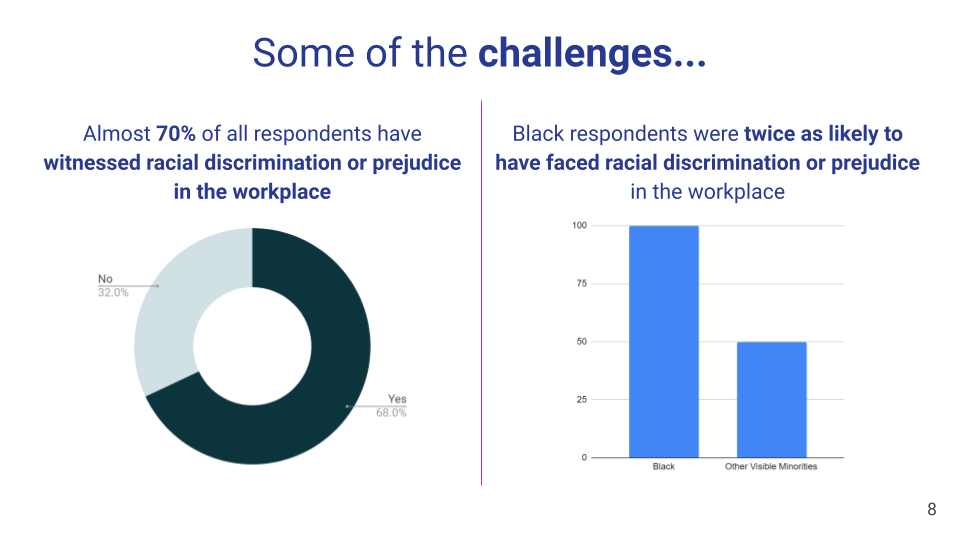Survey: Black employees are twice as likely to face discrimination in the workplace*
*In a December 2020 survey conducted by Lead to Change, Black respondents were twice as likely to have faced racial discrimination or prejudice in the workplace, as compared to other visible racial minorities. (Question: “Have you experienced racial discrimination or prejudice (either major or subtle) at work?”)
Results: 2020 Workplace Diversity
& Inclusion Survey
In December 2020, I launched Lead to Change, a workplace inclusion coaching service. As part of my effort to gauge the interest of potential clients and assess their needs relating to anti-racism workplace strategies and resources, I released an anonymous 10-question survey.
The 2020 Lead to Change survey included targeted questions related to workplace diversity, discrimination and potential supports. My goal was to gain real-time, actionable perceptions of workplace diversity and discrimination, and areas where I could provide support. Furthermore, I wanted to highlight areas requiring further research and discussion.
A small, racially diverse group of 30 public services employees were invited to participate. The response rate was strong at 83%, indicating strong interest in the topic. Twenty-five people completed the survey; the respondents self-identified as either White (13), Black (6) or other visible racial minority (6).
The survey questions focused on a few high-level areas:
Thoughts on workplace diversity and inclusion;
Perceptions of workplace discrimination and prejudice;
Personal discussions on race and racism; and
Preferred HR tools needed to better understand and address racial discrimination or prejudice in the workplace.
Key Takeaways:
1. Employees do believe that workplace diversity is important, but there are still some major issues that need to solved.
All respondents believe workplace diversity is important. However, almost 70% have witnessed racial discrimination or prejudice against a colleague (major or subtle).
All Black respondents have experienced workplace discrimination or prejudice compared to half (50%) of respondents who self-identified as other racial minorities.
2. Race and racism is a major topic of discussion, even in the workplace.
The majority of respondents spoke with colleagues about race and racism in 2020 (84%). White respondents were most likely to have these conversations (100%) compared to other respondents (67%) - which may reflect a burgeoning interest in allyship.
3. Black employees and other visible racial minorities want less ‘training’ and more ACTION; both groups want career coaching to navigate systemic barriers.
Another clear theme when identifying helpful tools is the need for safe spaces to listen, speak and share amongst co-workers. Over 80% of all respondents want facilitated discussions in the workplace on the subjects of race, racism and privilege.
Nearly 65% of respondents also expressed the need for leadership coaching to develop action plans for managing inclusive work teams. This may highlight a need to increase the capacity of people managers to proactively address workplace diversity challenges, maximizing team potential.
Actions For Workplace Leaders
Finally, our last finding is a crucial one: Only 56% of respondents believe their opinions matter at work (“a great deal” and “a lot”). Given that nearly 90% of respondents believe colleagues are respectful, this indicates almost half of employees (44%) may not feel valued by their leadership team.
Three actions that leaders could take to demonstrate the voices of employees are heard and valued on the topic of addressing racial discrimination and prejudice in the workplace are:
Support anti-racism efforts of employees and people-managers by providing access to action-oriented tools (e.g. facilitated sessions, coaching) that shift behaviours and contribute to more effective working relationships.
Deploy sufficient resources to root out and dismantle systemic barriers. This would ensure equal access to opportunities for all, thereby increasing capacity of teams to collaborate, execute and innovative.
Similar to other strategic priorities, regularly monitor, measure and communicate the organization’s progress and commitment to achieving anti-racism goals and fostering a safe and inclusive work environment.
To view the full results of Lead to Change’s survey,
download the free deck below!
(Note: Your email will be added to the Lead to Change mailing list where we send new resources, findings and surveys a few times a year. We won’t send you spam. You can unsubscribe at any time.)



